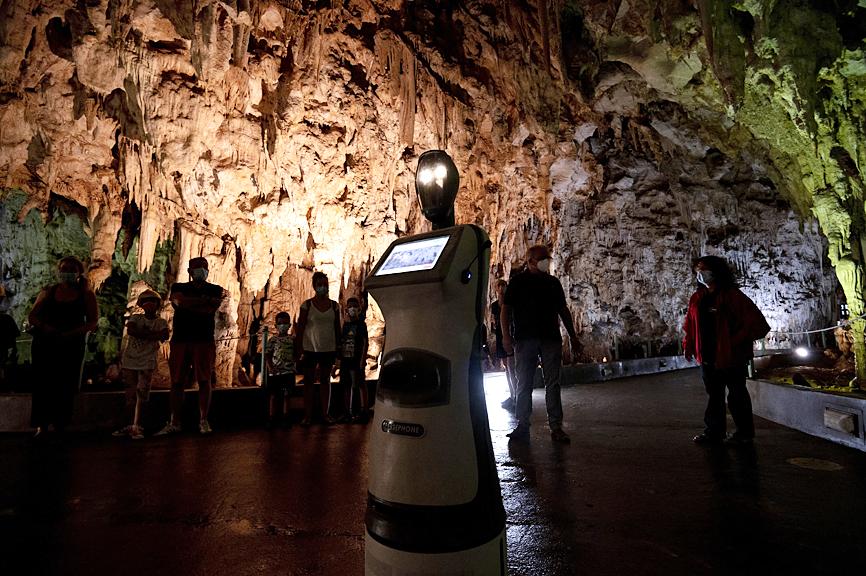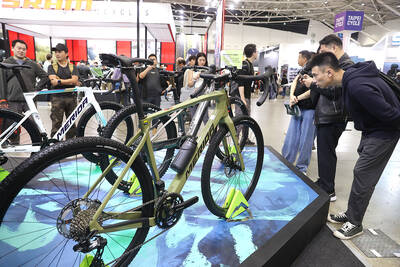Persephone is a tour guide in Greece, but perhaps not the type people are used to.
Billed as the world’s first robot tour guide inside a cave, Persephone has been welcoming visitors since the middle of last month to the Alistrati Cave in northern Greece, 135km northeast of Thessaloniki.
The multilingual robot covers the first 150m of the part of the cave that is open to the public. In the remaining 750m, a human guide takes over.

Photo: AP
The robot was named Persephone, because, according to one version of the ancient Greek myth, it was in a nearby plain that Pluto — the god of the underworld who was also known as Hades — abducted Persephone, with the consent of her father, Zeus, to take her as his wife.
The robot can give its part of the tour in 33 languages and interact at a basic level with visitors in three languages. It can also answer 33 questions, but only in Greek.
Nikos Kartalis, the scientific director for the Alistrati site, had the idea of creating the robot when he saw one on TV guiding visitors at an art gallery.
Seventeen years later, “we got our funds and the robot guide became a reality,” Kartalis told reporters.
The robot was built by the National Technology and Research Foundation and cost 118,000 euros (US$138,000).
“We already have a 70 percent increase in visitors compared to last year since we started using” the robot, Kartalis said. “People are enthusiastic, especially the children, and people who had visited in the past are coming back to see the robot guide.”
“It is something unprecedented for them, to have the ability to interact with their robot by asking it questions and the robot answering them,” he said. “Many foreign visitors couldn’t believe Greece had the capacity to build a robot and use it as a guide in the cave.”
The robot moves along a walkway, passing through an ornate landscape of stalactites and stalagmites. These varied formations can reach 15m tall and are seen throughout the cave’s nearly 1km walkway, which is accessible to people with limited mobility.
“This cave is one of the most beautiful, not only in Greece, but in Europe, as well,” Kartalis said. “It has stalactites and stalagmites in many shapes and colors, even red.”
He said the cave was 3 million years old and was first explored in 1974 by the Hellenic Speleological Society and a team of Austrian speleologists. It opened to visitors in 1998.
Persephone, with a white body, black head and two luminous eyes, moves on wheels, guiding visitors to the first three of eight stops along the walkway. She can do two more stops, but her low speed slows down the tour, which is conducted in three languages simultaneously. Persephone’s creators are considering ways to speed her up.
The robot’s begins by saying: “My name is Persephone, I am the daughter of the goddess Demeter and the wife of Pluto, the god of the underworld. I welcome you to my under Earth kingdom, the Alistrati Cave.”
Many visitors are intrigued by the robot guide.
“It was surprising for me. I’ve never experienced such a thing. Actually, honestly, I prefer a live guide, but it’s interesting doing it this way. And I like the pace of the robot. It goes slower, so I can look around,” said Patrick Markes, a Czech visitor.
Markes listened to the first three stops from the robot in his native language and the rest in English from a human tour guide.
“I should thank Persephone, our robot, she said very fine things,” said Christos Tenis, a Greek visitor. “I’m impressed by the cave. Of course, we had a flawless [human] guide, she explained many things. I’m very impressed.”
Persephone is not the only technology used inside the cave. There is a mobile app in which a visitor, scanning a QR code, can see the Alistrati Beroni. That is a microorganism that is only found in the cave, in the huge mounds of bat droppings left behind when the cave was opened and the bats migrated elsewhere.
Evdokia Karafera is one of the tour guides who partners with the robot.
“It is helpful, because it speaks many languages. There’s just a little delay in the touring,” she said. “Most find it fascinating, especially the children, and find it interesting that it speaks many languages.”
However, Karafera said that human tour guides cannot be completely replaced.
“Robots, at some point in the future, will take over many jobs. But I believe they cannot replace humans everywhere,” she said. “[Visitors say] the robot is interesting, original, but can’t substitute for the human contact with the guide and the conversation we can have on the way back.”

TECH CLUSTER: The US company’s new office is in the Shalun Smart Green Energy Science City, a new AI industry base and cybersecurity hub in southern Taiwan US chip designer Advanced Micro Devices Inc (AMD) yesterday launched an office in Tainan’s Gueiren District (歸仁), marking a significant milestone in the development of southern Taiwan’s artificial intelligence (AI) industry, the Tainan City Government said in a statement. AMD Taiwan general manager Vincent Chern (陳民皓) presided over the opening ceremony for the company’s new office at the Shalun Smart Green Energy Science City (沙崙智慧綠能科學城), a new AI industry base and cybersecurity hub in southern Taiwan. Facilities in the new office include an information processing center, and a research and development (R&D) center, the Tainan Economic Development Bureau said. The Ministry

ADVERSARIES: The new list includes 11 entities in China and one in Taiwan, which is a local branch of Chinese cloud computing firm Inspur Group The US added dozens of entities to a trade blacklist on Tuesday, the US Department of Commerce said, in part to disrupt Beijing’s artificial intelligence (AI) and advanced computing capabilities. The action affects 80 entities from countries including China, the United Arab Emirates and Iran, with the commerce department citing their “activities contrary to US national security and foreign policy.” Those added to the “entity list” are restricted from obtaining US items and technologies without government authorization. “We will not allow adversaries to exploit American technology to bolster their own militaries and threaten American lives,” US Secretary of Commerce Howard Lutnick said. The entities

Minister of Finance Chuang Tsui-yun (莊翠雲) yesterday told lawmakers that she “would not speculate,” but a “response plan” has been prepared in case Taiwan is targeted by US President Donald Trump’s reciprocal tariffs, which are to be announced on Wednesday next week. The Trump administration, including US Secretary of the Treasury Scott Bessent, has said that much of the proposed reciprocal tariffs would focus on the 15 countries that have the highest trade surpluses with the US. Bessent has referred to those countries as the “dirty 15,” but has not named them. Last year, Taiwan’s US$73.9 billion trade surplus with the US

The Taipei International Cycle Show (Taipei Cycle) yesterday opened at the Taipei Nangang Exhibition Center, with the event’s organizer expecting a steady recovery in the industry this year following a tough last year. This year, 980 companies from 35 countries are participating in the annual bicycle trade show, showcasing technological breakthroughs and market development trends of the bicycle industry at 3,600 booths, the Taiwan External Trade Development Council (TAITRA, 外貿協會) said in a statement. Under the theme “Ride the Revolution,” the exhibition has attracted more than 3,500 international buyers from 80 countries to preregister for the four-day event, which is expected to